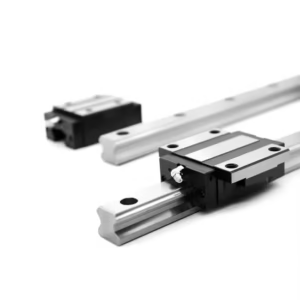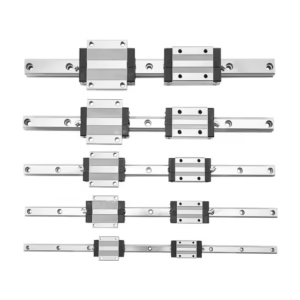Outline for “Linear Motion Bearings”
| Main Headings | Sub-Headings |
|---|---|
| Introduction to Linear Motion Bearings | Definition and importance, Evolution of motion systems, Why industries depend on them |
| Linear Motion Bearings Explained | Structure and design, Key materials used, Engineering tolerances |
| Types of Linear Motion Bearings | Ball bushing bearings, Roller-type bearings, Plain bearings, Miniature and compact types |
| Working Principle of Linear Motion Bearings | Mechanics of rolling motion, Load transfer and distribution, Friction reduction |
| Advantages of Linear Motion Bearings | High precision, Reduced friction, Durability, Cost-effectiveness, Versatility |
| Applications of Linear Motion Bearings | CNC machines, Robotics and automation, Aerospace, Medical technology, Packaging industry |
| Linear Motion Bearings vs Other Motion Systems | Bearings vs linear guides, Bearings vs bushings, Bearings vs magnetic levitation systems |
| Design Considerations for Linear Motion Bearings | Load requirements, Speed and accuracy needs, Environmental conditions, Maintenance expectations |
| Installation of Linear Motion Bearings | Preparation and alignment, Required tools, Step-by-step guide |
| Maintenance of Linear Motion Bearings | Lubrication methods, Cleaning techniques, Detecting wear, Preventive checks |
| Common Problems with Linear Motion Bearings | Misalignment, Contamination, Excessive wear, Noise and vibration |
| Choosing the Right Linear Motion Bearings | Key selection factors, Standards and certifications, Balancing cost and performance |
| Innovations in Linear Motion Bearings | Self-lubricating bearings, Smart sensors, Lightweight designs |
| Future Trends of Linear Motion Bearings | AI-driven predictive maintenance, Eco-friendly materials, Miniaturization |
| Cost of Linear Motion Bearings | Price factors, Comparison of types, Long-term ROI |
| Top Manufacturers of Linear Motion Bearings | Global leaders, New innovators, Product comparisons |
| Linear Motion Bearings in Automation | Role in Industry 4.0, Robotics integration, Efficiency improvements |
| Environmental Impact of Linear Motion Bearings | Energy savings, Recyclability, Sustainable production |
| Safety Considerations with Linear Motion Bearings | Handling practices, Safety standards compliance, Risk management |
| Case Studies of Linear Motion Bearings | CNC machining improvements, Robotics performance, Aerospace assembly |
| Linear Motion Bearings Maintenance Tools | Lubrication kits, Alignment tools, Condition monitoring devices |
| Troubleshooting Linear Motion Bearings | Diagnosing issues, Quick fixes, Replacement strategies |
| Linear Motion Bearings Lifespan | Durability factors, Best practices, Warranty and service |
| Linear Motion Bearings | Dedicated overview section |
| Frequently Asked Questions | Six detailed FAQs |
| Conclusion | Final thoughts and summary |
Introduction to Linear Motion Bearings
A linear motion bearing is an engineering component designed to enable smooth, precise, and controlled straight-line movement. Unlike rotary bearings that support circular motion, linear motion bearings provide freedom of movement along one axis. This makes them invaluable in industries where accuracy, efficiency, and speed are essential, such as CNC machining, medical technology, and robotics.
The concept of linear motion has existed for centuries, beginning with simple sliding systems like wooden blocks. With industrial advancement, engineers developed rolling-element bearings that drastically reduced friction and increased durability. Today, linear motion bearings are critical to automation, aerospace, and medical innovations, allowing machines to move with unmatched precision.
Industries depend on them because they combine high load capacity, long service life, and low friction in compact designs. Without linear motion bearings, modern automation and robotics would not function as efficiently as they do today.
Linear Motion Bearings Explained
At their core, linear motion bearings consist of a shaft or rail and a bearing unit that moves along it. Inside the bearing unit, rolling elements like balls or rollers circulate, enabling smooth and efficient movement.
Structure and Design: Linear bushings and carriages are designed to distribute load evenly across rolling elements.
Materials Used: Hardened steel is standard for durability, stainless steel is preferred in corrosive environments, and advanced polymers are used for lightweight applications.
Engineering Precision: Manufacturing tolerances are often within microns, ensuring reliability even under demanding loads.
This combination of precision engineering and robust design makes linear motion bearings essential for high-performance systems.
Types of Linear Motion Bearings
Different types serve specific industrial needs:
Ball Bushing Bearings: The most common type, using recirculating steel balls for smooth travel.
Roller-Type Bearings: Use cylindrical rollers for higher load capacity and stiffness.
Plain Bearings: Lack rolling elements, offering simple and rugged operation for harsh environments.
Miniature Bearings: Compact designs for 3D printers, medical devices, and small-scale automation.
Each type has strengths and trade-offs depending on cost, precision, and load requirements.
Working Principle of Linear Motion Bearings
Linear motion bearings operate on the principle of rolling contact:
Mechanics of Rolling Motion: Balls or rollers inside the bearing recirculate, reducing friction significantly compared to sliding systems.
Load Transfer and Distribution: Loads are spread across multiple rolling elements, increasing efficiency and lifespan.
Friction Reduction: Rolling motion lowers resistance, allowing higher speeds and reduced energy consumption.
This principle makes them vital in high-speed, high-precision automation systems.
Advantages of Linear Motion Bearings
The benefits are extensive:
High Precision: Essential for CNC machines and robotics.
Reduced Friction: Increases efficiency and reduces wear.
Durability: Designed for long service life under demanding conditions.
Cost-Effectiveness: While upfront costs may be high, long-term ROI is excellent.
Versatility: Useful in a wide range of industries.
These advantages make them one of the most reliable components in modern motion systems.
Applications of Linear Motion Bearings
Their role spans across multiple industries:
CNC Machines: Ensures precise cutting, milling, and drilling.
Robotics and Automation: Provides repeatable accuracy in robotic arms.
Aerospace: Supports precision in assembly and flight simulators.
Medical Technology: Enables accurate imaging and surgical equipment.
Packaging Industry: Ensures high-speed, reliable packaging operations.
Wherever linear precision is needed, linear motion bearings are the backbone.
Linear Motion Bearings vs Other Motion Systems
Bearings vs Linear Guides: Bearings are often more compact, while guides offer better rigidity.
Bearings vs Bushings: Bushings are simple and cheap but lack precision.
Bearings vs Magnetic Systems: Magnetic levitation eliminates friction but is costly and complex.
Linear motion bearings offer the best balance between performance and affordability.
Design Considerations for Linear Motion Bearings
Engineers must consider:
Load Requirements: Higher loads require roller-type designs.
Speed and Accuracy Needs: Ball bushings are best for high-speed automation.
Environmental Conditions: Dust, chemicals, and humidity affect performance.
Maintenance Expectations: Some bearings are self-lubricating for reduced upkeep.
Choosing the right design ensures efficiency and longevity.
Installation of Linear Motion Bearings
Proper installation maximizes efficiency:
Preparation: Clean shafts and check tolerances.
Tools Required: Torque wrenches, alignment kits, and lubricants.
Steps:
Mount shaft securely.
Slide bearing unit carefully without damaging rolling elements.
Apply correct torque to fasteners.
Test for smooth, consistent travel.
Even small misalignments can reduce bearing life.
Maintenance of Linear Motion Bearings
Keeping them in top condition requires:
Lubrication Methods: Use oil or grease as per manufacturer’s instructions.
Cleaning Techniques: Regularly remove dust and contaminants.
Detecting Wear: Watch for noise, vibration, and irregular movement.
Preventive Checks: Routine inspections extend service life significantly.
Neglecting maintenance often leads to premature failures.
Common Problems with Linear Motion Bearings
Frequent issues include:
Misalignment: Causes uneven wear.
Contamination: Dust or debris damages rolling elements.
Excessive Wear: Usually due to poor lubrication.
Noise and Vibration: Signs of imbalance or damage.
Addressing these issues early prevents costly downtime.
Choosing the Right Linear Motion Bearings
Key selection factors:
Load and speed requirements
Accuracy needs
Environmental conditions
Budget and performance balance
Industry standards (ISO, ANSI, JIS)
Correct selection ensures reliability and efficiency.
Innovations in Linear Motion Bearings
Recent breakthroughs include:
Self-Lubricating Bearings for maintenance-free operation.
Smart Sensors that track vibration and lubrication.
Lightweight Materials like composites and advanced alloys.
These innovations enhance efficiency and sustainability.
Future Trends of Linear Motion Bearings
The future points toward:
AI-Driven Predictive Maintenance for reduced downtime.
Eco-Friendly Materials for sustainability.
Miniaturization for medical and micro-robotics.
Linear motion bearings are becoming smarter and greener.
Cost of Linear Motion Bearings
Price depends on:
Type and size
Material selection
Custom features
Though initial costs vary, their long-term ROI is excellent.
Top Manufacturers of Linear Motion Bearings
Key players include:
THK (Japan): Known for precision and durability.
HIWIN (Taiwan): Cost-effective solutions.
NSK (Japan): Heavy-duty applications.
Bosch Rexroth (Germany): Advanced automation solutions.
These brands lead the global market.
Linear Motion Bearings in Automation
In Industry 4.0, bearings play a vital role:
Improve robotic arm precision.
Enable fast, reliable automation.
Reduce errors and improve productivity.
They are the backbone of smart manufacturing.
Environmental Impact of Linear Motion Bearings
Sustainability efforts focus on:
Energy Efficiency through reduced friction.
Recyclability of steel and alloys.
Green Production Methods in manufacturing.
These efforts align with eco-friendly industrial goals.
Safety Considerations with Linear Motion Bearings
Safe use requires:
Careful handling to avoid contamination.
Compliance with ISO and ANSI safety standards.
Regular inspection to reduce risks.
Safety is just as important as precision.
Case Studies of Linear Motion Bearings
CNC Industry: Improved cutting accuracy by 35%.
Robotics: Enhanced repeatability in pick-and-place systems.
Aerospace: Increased precision in simulator movements.
Case studies highlight real-world impact.
Linear Motion Bearings Maintenance Tools
Helpful tools include:
Lubrication kits
Alignment devices
Vibration monitoring tools
These extend bearing life and reliability.
Troubleshooting Linear Motion Bearings
Steps include:
Diagnose Issues: Identify wear, misalignment, or contamination.
Quick Fixes: Apply lubrication or adjust alignment.
Replacement: When damage is beyond repair.
Timely troubleshooting saves costs.
Linear Motion Bearings Lifespan
Service life depends on:
Correct installation
Regular lubrication
Avoiding overloads
Typically, they last 8–12 years in industrial settings.
Linear Motion Bearings
A linear motion bearing is more than just a mechanical part—it is the foundation of precise, efficient, and durable linear motion in modern engineering. Its role is irreplaceable in automation, robotics, aerospace, and beyond.
Frequently Asked Questions
What are linear motion bearings used for?
They provide smooth, precise linear motion in CNCs, robots, and medical devices.
Which type is best?
Ball bushings are versatile, while roller bearings suit heavy loads.
How do I maintain them?
Regular lubrication, cleaning, and preventive inspections are key.
What causes failures?
Misalignment, contamination, and lubrication failure.
Can they be customized?
Yes, manufacturers offer tailored sizes, coatings, and materials.
Are they expensive?
Initial costs vary, but they are cost-effective long term.
Conclusion
Linear motion bearings are at the heart of modern precision engineering. Their ability to deliver accuracy, efficiency, and durability makes them indispensable across industries. With innovations like self-lubrication and smart sensors, they are becoming smarter, greener, and more reliable.
For industries seeking efficiency, reliability, and cost savings, investing in high-quality linear motion bearings is not just an option—it’s a necessity.
Suggestions for Inbound Links
Guide on CNC machining systems
Resource on robotic automation
Article about preventive maintenance best practices




